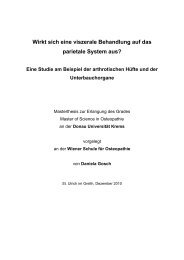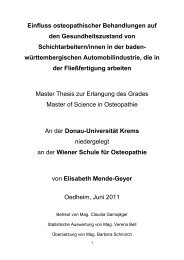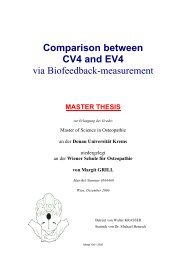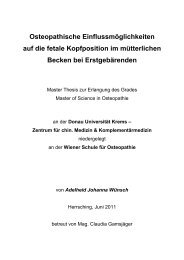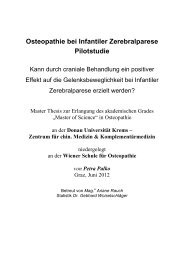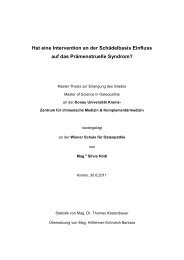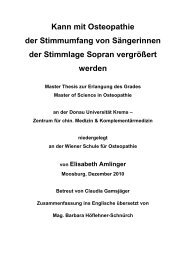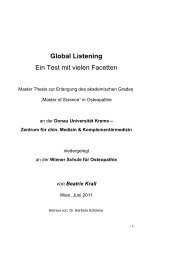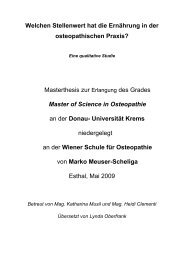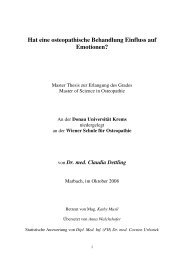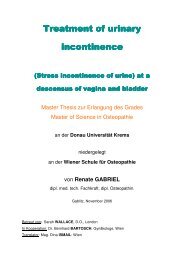Risch Andreas.pdf - Osteopathic Research
Risch Andreas.pdf - Osteopathic Research
Risch Andreas.pdf - Osteopathic Research
Sie wollen auch ein ePaper? Erhöhen Sie die Reichweite Ihrer Titel.
YUMPU macht aus Druck-PDFs automatisch weboptimierte ePaper, die Google liebt.
I would like to emphasize here again that the results of this study is concerning only<br />
the interviews retrieved from 10 German speaking osteopaths and should not be<br />
considered representative of all osteopaths.<br />
A total of 1422 metaphors were identified in this study of 10 interviews by Germanspeaking<br />
osteopath with an academic background. Two thirds of all the metaphors<br />
identified were assigned to 10 categories, more than half to 5 categories. Overall<br />
there were three single categories, which claimed the highest scores of metaphors,<br />
„OSP“ (Other Sensory Perception) (15%, HEALTH AS AWARENESS, INTUITION,<br />
FEELING, CONFIDENCE), „orientation“ (12%, HEALTH AS GUIDE FOR<br />
DIRECTION, WAY, PATH, LEADING, ACCOMPANYING, GUIDING) and „STC“<br />
(Science/Technique/Crafts) (10%, HEALTH AS PROCESS, PATTERN,<br />
REGULATION, INTERACTION, USE, FUNCTION) while the total amount of<br />
metaphors is divided among the sensory experience group with 358 (25%), the<br />
physical body experience group with 566 (40%) and the thematic experience group<br />
with 498 (35%) of metaphors.<br />
Special attention is given to the OSP category which is the highest individual<br />
category and clearly demonstrates the most frequented category in the quantitative<br />
distribution of metaphors. This category contains complex sensory-affective-cognitive<br />
aspects and resembles a smooth transition to the image schemata of the physical<br />
body experience group. These expressions already point to the process of the<br />
generation of mental models and consciousness (Lakoff/Johnson, 1980). They are<br />
primarily interoceptive, reveal in my opinion a high state of empathy of the osteopath<br />
in the individual relationship with the patient and represent an important part in the<br />
conceptualization of health among the individual interviewed osteopaths.<br />
“Change” and “association” are the two main concepts in the physical body<br />
experience group and serve as an explanation and help to understand the OSP<br />
experiences in affiliation with the personality model according to Riemann-Thomann-<br />
Modell (2003) as already outlined in the qualitative analysis. These concepts reveal<br />
in my opinion a conflict in the overall osteopathic concept. It seems to be very difficult



